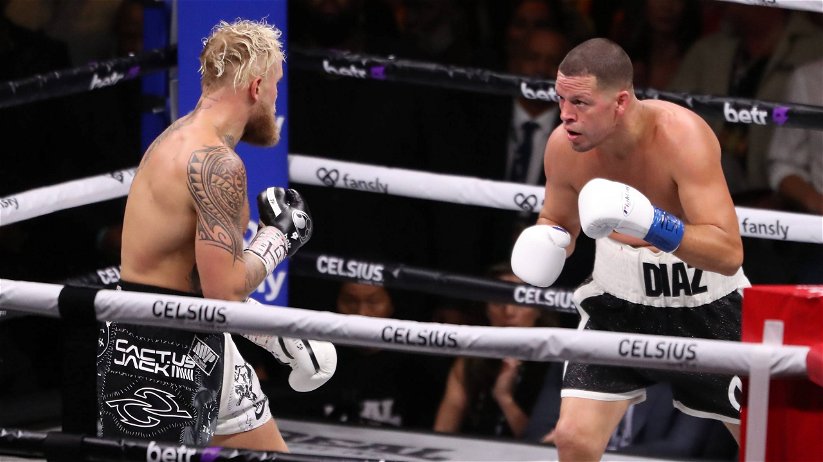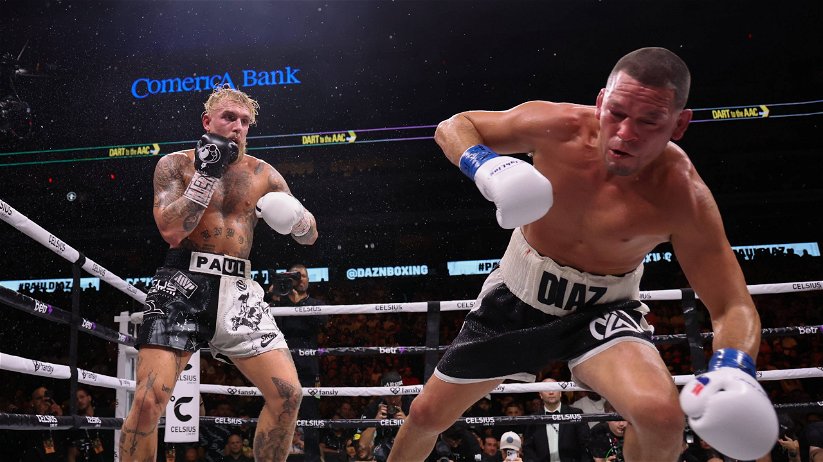Jump to
Terence Crawford’s name is etched in history now.
This was supposed to be close, with two of the best pound-for-pound fighters in the world facing off to establish who was the king of the welterweight division.
Instead, Errol Spence found himself outclassed and battered, knocked out in the ninth but dissected every step along the way.
This wasn’t just a great performance from Terence Crawford, it was an all-timer. It’ll be remembered for decades. He also became the first man to unify all four belts in two divisions, so that’ll go into the books too.
So how’d he do it? Let’s take a look.

The Breakdown: How Terence Crawford beat Spence
A quick note before we start: as always, there was the question of whether Terence Crawford would choose orthodox or southpaw stance against the naturally-southpaw Spence.
As it happened, he matched his opponent, making for a closed-stance matchup.
The first round was pretty much as expected, the two sizing each other up, Errol Spence a little busier. There were some warning signs early in the second round already though that Crawford was starting to see a route.
Spence has been caught leaning in as he comes forward before, but it’s usually a marginal issue, something that an opponent can occasionally get a shot off on. Crawford caught him for it for the first time in the second.
Shortly after, Spence did get in close safely but was then immediately shoved back, which was worrying since he was supposed to be the bigger stronger man and needed to have the advantage inside.
The real blow to Spence’s confidence came right at the end of the round, though. He reached in with a body jab and then, anticipating a counter, drew back to make his escape.
Rather than just letting him go, Crawford chased him, throwing a 2-1 and clipping him with the jab hand. It wasn’t a particularly hard shot, but Spence was way off balance and fell.
It was close to the end of the round and once he made it to the bell it became clear he wasn’t physically particularly hurt by it, but the damage to his confidence became apparent quickly.
The problem was that one of Spence’s biggest advantages has always been his ability to move backwards very quickly if need be.
He’s comfortable in his ability to keep a constant smothering pressure on because, if an exchange does get uncomfortable, he can get to safety, reset, and resume the attack on more favourable terms.
He found out with that knockdown that that wasn’t going to be the case here.
The other big issue? The jab. Spence lives and breathes off working in behind that punch, thrown in doubles and triples as he moves forward.
Now, Spence isn’t a fighter who necessarily needs his jab to land to work behind it (unlike Stephen Fulton, who had real trouble against Nayoa Inoue on Tuesday with a similar problem issue).
If his opponent is reacting to it and giving up space to deal with it, that’s enough. The problem was that Crawford really wasn’t bothered by it at all.
It barely landed, but even when it did he almost always in a good defensive position after Spence finished throwing it and closed the range.
The reverse, on the other hand, was not true. Crawford’s jab would interrupt Spence’s movement and posture constantly, and that massively exacerbated his problems with balance.
Let’s be clear here: Spence has never been a defensive fighter, no, but he’s usually been able to slip, smother or move with punches well enough to both avoid too much damage and to keep his offense rolling.
Here, because Crawford’s jab was so disruptive, he was mostly working off imperfect positions. That turned usually small gaps in his armour into big gaps, and led to the frankly ludicrous 60% connect rate on power punches registered by Compubox.

Those interceptions were made easier by the fact that, while he isn’t a one-pace fighter in the sense of constantly throwing at one set speed all the time, he does tend to fall into certain beats of timing.
The actual attacks and combinations aren’t always the same, but he can get into certain rhythms, and end up always throwing on that beat.
He doesn’t have the easy knack of holding a movement for half a beat, or just a fraction, to react to the opponent’s own timing, and he felt very uncomfortable because Crawford does.
If he’s not sure what’s coming, he’ll hold for just a second to see what’s up. If he is sure what’s happening, he can choose his moment precisely to deliver the most damage.
What that meant was that, after Spence threw a jab, Crawford knew when the next move was coming. He didn’t always know what it would be- that took a bit more work- but if Spence’s stance said a follow-up was coming, there was little chance of Crawford going too soon and falling short with his interception.
Likewise, if the stance said Spence would hold off or move away, Crawford would feel comfortable stepping or even leaning in a bit, knowing there wasn’t a hidden surprise to punish him- that also contributed to the first knockdown.
The last big piece of the puzzle- and the ‘figuring out the next move’ play- for Crawford was, as expected, his famous trap-setting and baiting. Spence was always going to need to keep pushing to win, but because of early adversity he clearly didn’t feel he had time to get his bearings, and Crawford exploited that to the max.
In particular, he used his excellent active guard as a feinting tool. He’d put up one defence, knowing full well Spence would throw at the gap he thought it left. He’d then adjust, defend the shot, and counter (or, if he felt comfortable enough, just beat Spence to the punch).
Watch for example the above, the first knockdown in the seventh. They’re close up in the middle of the ring, with Bud in a shell guard (that is, lead hand low, left hand by his chin). Spence sees an opening in that low lead hand, and throws an overhand left to the head.
Crawford slides back from it, but instead of pushing Spence back or circling away, he fades to the ropes. Spence senses a similar opening and throws the same punch, but this time Crawford brings his lead hand up in a short uppercut that staggers him, and follows it with a chopping overhand with the same hand that puts him on the floor.
You can see a similar dynamic play out with that particular combination throughout the fight- particularly in the ninth, before the finish Crawford punishes the same looping left a couple of times.
There were numerous other pieces of bait dangled, though, and it was one of those that, in combination with pretty much all of the above factors, led to the finish.
The Finish: How Terence Crawford got it done
Spence normally loves an opponent with a static high guard in front of him, as he can freeze it in place with a couple of shots upstairs then aim to work the body.
Terence Crawford knew this, and would throw up a high guard for Errol Spence to bite on throughout the fight. In the final exchange, he did it again. Spence came at it with a double jab, then paused.
At that point Crawford knew he had a beat of Spence’s typical rhythm free before anything else came, so he was ready to act on whatever it proved to be.
As it happened, Spence tried to batter past that high guard with the same overhand left. Crawford caught and countered with the right hand, and since Spence had overbalanced again in throwing it, it sent him staggering.
It was a formality after that- Crawford chased Spence, unloading, and referee Harvey Doc had no choice but to wave it off.
It was, ultimately, a performance that showed us the difference between the very good and the truly great. The errors Spence showed are not huge, and no opponent to date has been able to truly punish him for them. Crawford, though, made them look like gaping chasms.
The timing and the ability to adjust on show were truly remarkable, and Spence’s own adjustments were just too limited to make a difference. It was brilliant, and anyone who’s thinking about belittling Spence for how he looked here should have a word with themselves. He simply came up against a master.
What’s next for Terence Crawford and Errol Spence?
We know they have a rematch clause, so what’s next is probably that. It’s up to Errol Spence whether to activate it — but it’s up to Terence Crawford what division they fight in.
Since Spence indicated clearly that he’s no longer comfortable at weltwerweight and would prefer it at light-middleweight, that could be a snag—but Crawford also said post-fight that he’s quite happy moving to 154, so we could see it there. Probably before the end of the year, but a lot will depend on how Spence heals.
If they do choose to go a different way, the only really interesting opponent for Crawford remaining at welterweight is rising star Jarron Ennis.
That’s a fun fight because Ennis is a brilliant fighter in all areas, comfortable switching between them and much bigger than Crawford- but a performance like this does suggest it might just be a bit too soon for the younger man.
Still, Ennis would be itching to prove he’s elite himself. Since Ennis, while not with Al Haymon’s PBC platform, is associated with Showtime, it should be pretty makeable.

For Spence, meanwhile, 154lbs offers a number of opponents. Jermell Charlo, the unified champion, is seemingly off on an adventure up to 168lbs to fight Canelo.
If he doesn’t, or comes back down quickly, Spence would love that fight- but if not, the belts split, and he’ll have opportunities to start picking them up. So that’s definitely the future for him. Even if the rematch does happen, he’ll be campaigning at super-middle after that.
Is a rematch necessary? Only Errol Spence can really decide. After a performance like that, it doesn’t seem much that he can do to close the gap, but he’s got his pride, and he is still very good.
Worst case scenario, we get a repeat of a masterclass from Terence Crawford.
Join the Bloody Elbow Substack!
Support Bloody Elbow, and get exclusive content.
About the author



